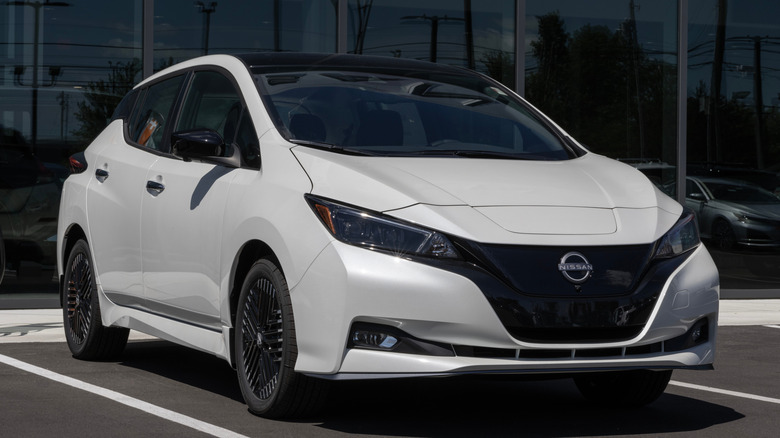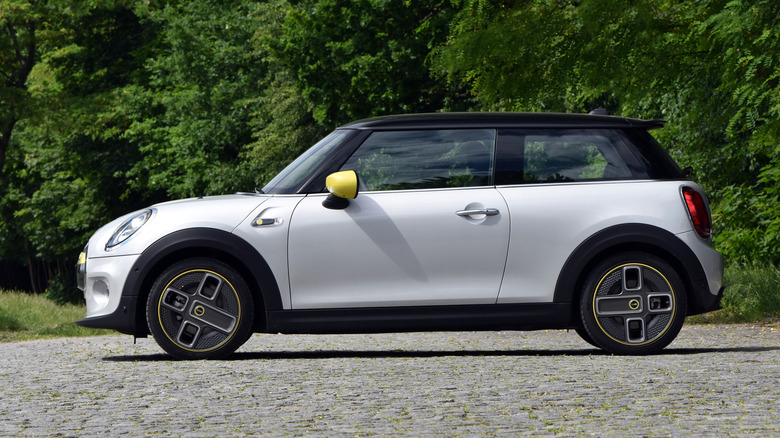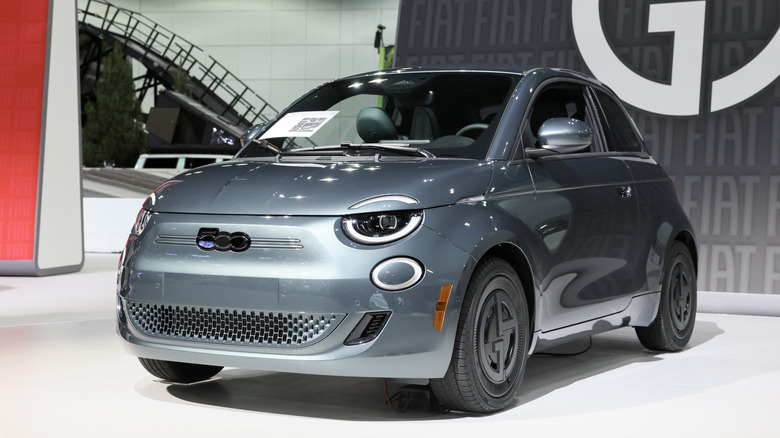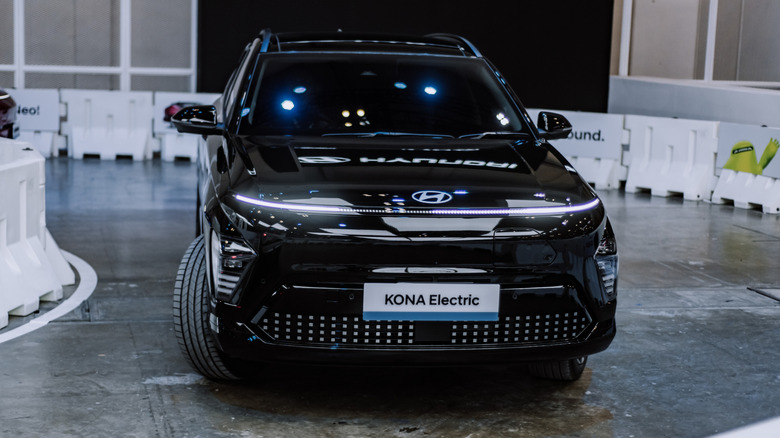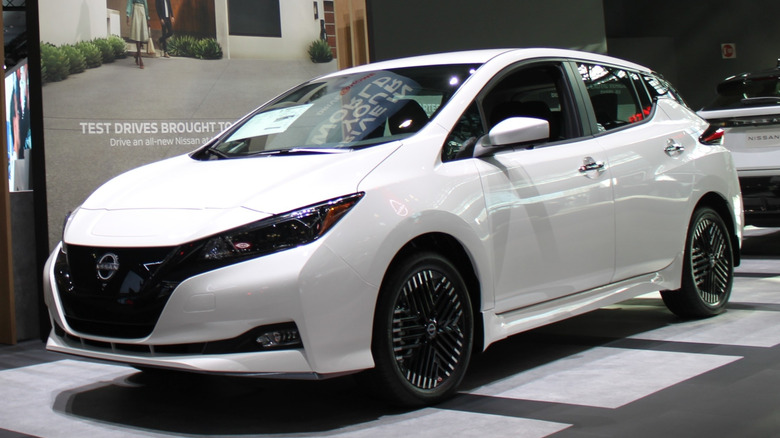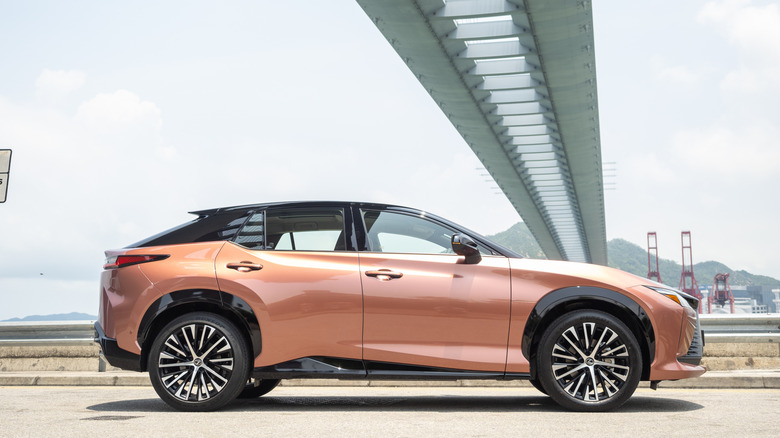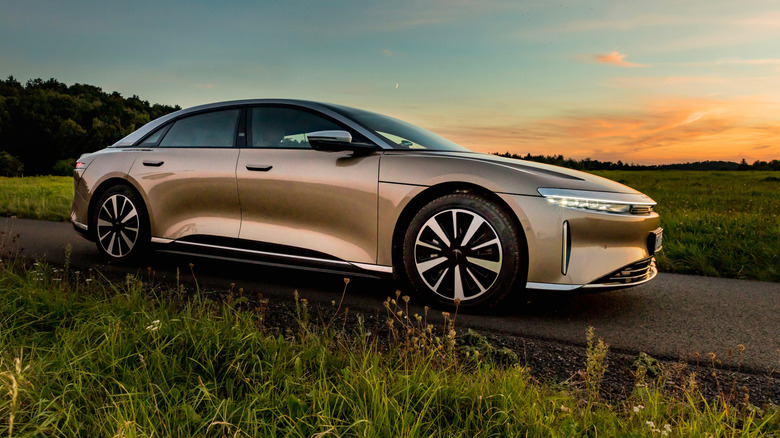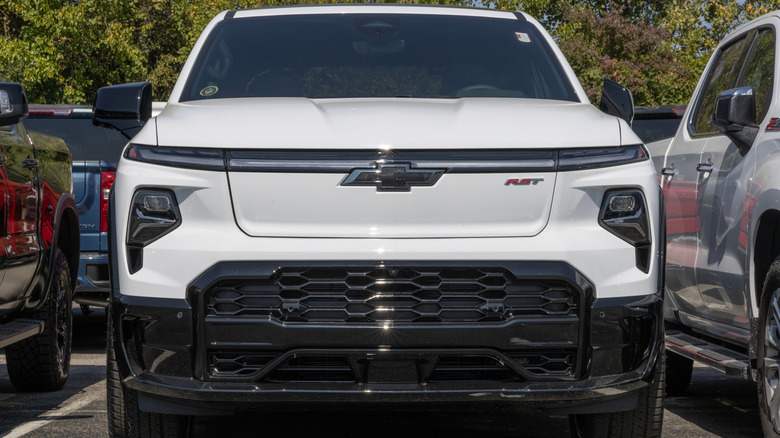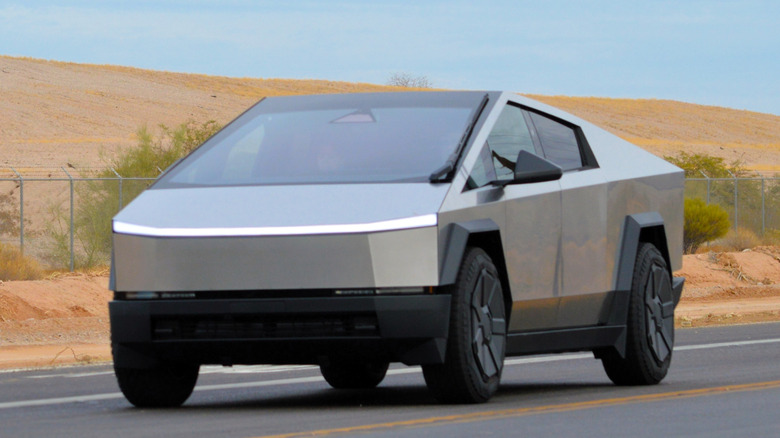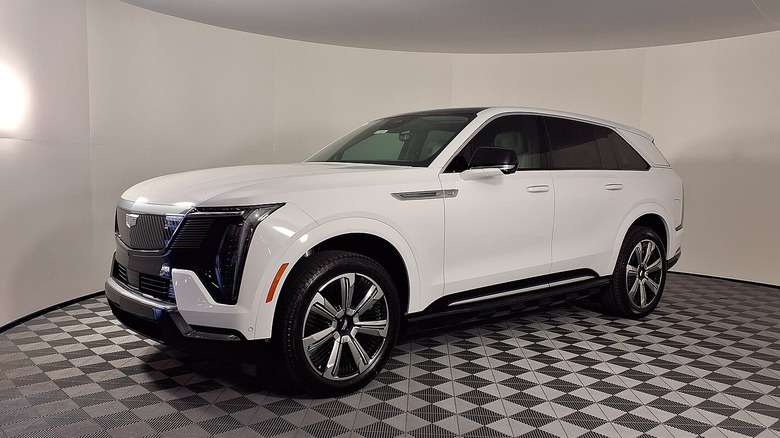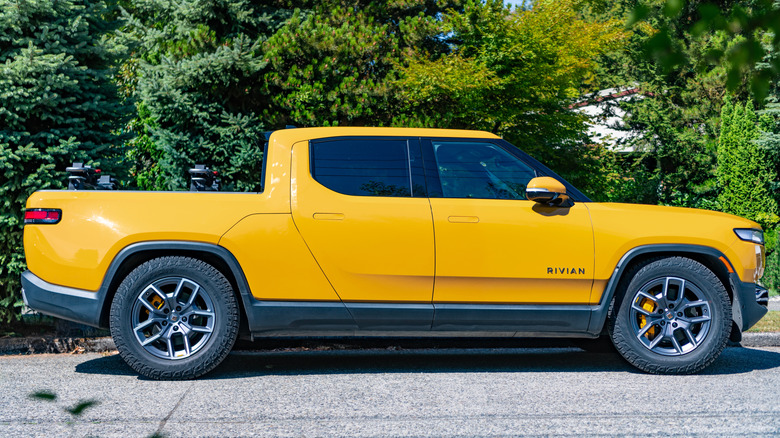5 EVs With The Worst Range (And 5 With The Best)
In 1996, General Motors' radical and tear-drop-shaped EV1 stunned the public with its futuristic looks and roughly 100-mile range (under ideal conditions) before needing a recharge. Unfortunately, the EV1 had to make radical compromises to achieve even that limited range. With a 1,175-pound battery pack, it needed to be a tiny and ultra-aerodynamic two-seater — not exactly the ideal form for most drivers. GM eventually destroyed almost all of them, so the EV1 is now one of the rarest cars in the world.
Fast forward almost three decades, and electric vehicles (EVs) have made tremendous strides in both range and practicality. Today they are the same size and shape as internal combustion vehicles, offering the same versatility to American drivers as the cars they're used to. But range is always the crucial factor in determining whether an EV can meet the average driver's needs, and it's that area in which they've improved the most. At least, for the most part. Some vehicles haven't come quite as far as others. A smaller vehicle might not offer room for a large battery pack, and all other things being equal, a larger battery can hold more energy. The energy-to-weight ratio of the battery matters, too. Plus, electric car batteries are expensive to build, so in smaller and generally cheaper vehicles, smaller batteries make more sense.
The list below provides evidence for these factors, as some older and smaller EVs like the Nissan Leaf are on the "Five Worst" list while newer models from Lucid Motors or larger ones like the Chevy Silverado EV RST are on the "Five Best" list. Bear in mind these rankings apply only to range, and not to the reliability, affordability, or fun-to-drive quotient of each vehicle, which may matter more than the range for some drivers.
The Worst: MINI Cooper SE
MINI enjoys a reputation for small, quirky, fun-to-drive vehicles, and the $30,900 electric MINI Cooper is no exception. However, with a range of only 119 miles, it's hard to justify the MINI Cooper SE as a practical daily commuter. It might seem like enough miles for your trip to the office and back, but extreme weather and other factors can reduce that range. Plus, as with most EVs, the highway range is lower, standing at just 100 miles because of greater wind resistance and less regenerative braking to recharge the battery.
However, if your commute is shorter (or you work from home), the MINI Cooper SE could be a good choice of EV. Its handling is excellent, although at the cost of a firm ride, and its recognizable MINI style sets it apart from most other cars. The acceleration is good and the controls are nicely ergonomic. There's a lot to like here.
The SE features a 28.9-kWH lithium-ion battery that gives its electric motor enough juice for 181 horsepower and a decent 199 lb-ft of torque. As with many EVs, its torque produces nice off-the-line acceleration for spirited driving, although having too much fun leaving stoplights will reduce the range. A full charge requires 24 hours on a 120-volt outlet or 8 hours on a 240-volt outlet. DC fast charging can bring the battery to 80% capacity in 36 minutes. A new MINI Cooper SE should arrive soon, and it's safe to bet it will feature quite a bit more range. Overseas, electric MINI Coopers come with 40.7-kWH or 54.2-kWH battery choices offering substantially more range and faster charging. We can expect to see similar numbers in North America with the next model.
The Worst: Fiat 500e
The Fiat 500e is an almost impossibly adorable city runabout, like something from Pixar's "Cars" come to life. But with a range of only 149 miles, you wouldn't want to venture far beyond the city. Like many Italian cars, the 500e serves almost as much as an expression of personal style as transportation. At a starting price of $32,500, it's a pretty affordable fashion statement for an electric car.
The interior is swoopy, futuristic, and equipped with the tech you would expect in a modern electric car, like a digital gauge display, a touchscreen infotainment center, active cruise control, and wireless phone charging. Its tiny size makes it barely more than a two-seater, however, and could be one reason for its limited range, since there isn't a lot of room for the battery inside its pint-sized body.
That battery is a 37.0-kWH unit that powers a 117-horsepower AC motor that also produces 162 lb-ft of torque. This is good for a sub-eight-second 0-60 time, so it has fun off-the-line grunt while its tiny size makes it very maneuverable in city traffic. But the trade-off for its toy-car dimensions is its poor driving range, which drops to 141 miles on all-season tires. At a fast-charging station, an 80% charge requires approximately 50 minutes, so keeping the little Fiat fed with juice will take some planning. Still, city dwellers with a charging spot in their parking garages may find it a fine choice.
The Worst: Hyundai Kona Electric (Base Model)
The Kona is an agile and well-packaged little SUV with plenty of charm, although in its base Kona Electric edition, its range is limited to only 200 miles. Still, for its base price of $42,440, it certainly looks the part of a vehicle from an electric future, with creases and angles throughout its compact SUV body, along with LED light strips for headlights and tail lights. Its spacious and cleverly designed interior comes in green with neon green accents, perhaps to remind drivers that they own an eco-friendly vehicle.
That interior also sports some cutting-edge tech including twin 12.3-inch displays, one of which offers an overhead birds-eye view of the Kona and its surroundings for easier parking. A recent redesign gave the Kona larger dimensions, translating into a more comfortable interior. Hyundai has developed a reputation for well-designed passenger cabins and is even considered one of the brands with the nicest interiors. For example, a trick center console features retractable cup holders to open up the space between the front seats and provide extra storage for valuables. The ride is comfortable and quiet with a decent 7.0-second 0-60 time, although that is slightly slower than the previous generation of Kona Electric.
The Kona Electric offers a choice of two batteries, a 48.6-kWH base edition battery and a 64.8-kWH unit. Either one pairs up with a 201-horsepower AC motor with 188 lb-ft of torque. The 48.6-kWH battery is the one that lands the Kona Electric's base model on this list with its 200-mile range. With a window sticker that's close to the price of an average new car, that's not much range for your dollar, but drivers who value well-designed cabins and "Blade Runner" aesthetics might find that a worthwhile trade-off.
The Worst: Nissan Leaf
Including the Leaf on this list might seem unfair, since it was one of the pioneers that made all-electric driving available to the masses. However, its age is showing, and this is reflected in its range of only 212 miles, even in the 2025 model. While its $29,280 base price makes it one of the cheapest EVs on the market, the Nissan Leaf has long had a reputation for terrible resale value, offsetting its initial affordability to some extent. Plus, it lost the federal EV tax credit for the 2025 model year.
Despite these drawbacks, the Leaf is hardly a penalty box on wheels. The seats are comfortable and the rear seat and cargo area are both eminently usable. The hatchback increases its versatility. Visibility through its large windows is excellent. Its positive points are strong enough that US News & World Report ranked it number two in an EV comparison. The Leaf still has fans.
However, the Leaf S base model features only a 40.0-kWH battery pack mated to a 147-horsepower electric motor, so it won't exactly be challenging supercars to stoplight drag races. A full charge is relatively slow for such a small battery too, at seven hours. Stepping up to the Leaf SV Plus gets a 214-horsepower motor and a larger battery, but pushes the price north of 37 grand. The smaller battery pack is arguably a better buy for drivers without a long commute.
The Worst: Lexus RZ450e
The RZ450e offers all the thoughtful comforts and conveniences we expect from Toyota's luxury division. However, its 220-mile range is less convenient, and replaces comfort with range anxiety. This compact SUV shares a platform with the Toyota bZ4X, which is also badged as the Subaru Solterra.
There are actually two Lexus RZ models: The RZ450e, which starts at $48,675, and the RZ300e, starting at $43,975. The more expensive RZ450e gets its zoom from a dual-motor AWD setup powered by a 71.4-kWH battery. It offers plenty of power and torque: 308 horsepower and 320 lb-ft of torque. This makes it something of a compact electric muscle car, or a muscle SUV if there is such a thing. Motor Trend observed a 0-60 time of only 4.6 seconds — pretty zippy for a Lexus. The tradeoff, however, is the 220-mile range. Recharging is mediocre, with an 80% fast charging time of 30 minutes. Using a home charger with a 240-volt outlet yields a full charging time of 9.5 hours.
On the plus side, it's still a Lexus, so drivers will enjoy all the creature comforts and thoughtful touches that come with the Lexus badge. These include a heated steering wheel and front seats, auto-dimming side view mirrors, and a huge 14.0-inch touchscreen among other things — all as standard. It sports driver-assist and safety features galore. In fact, it's a 2024 IIHS Top Safety Pick in part due to its technology. Extra options include a Mark Levinson sound system.
The Best: Lucid Air (Several Model Trims)
Among electric car makers, Lucid Motors might seem like a bolt from the blue. The Newark, California-based company built its first production car in 2022 in its factory in Arizona, making it one of the youngest car manufacturers in the world — but this precocious company has made a huge splash. Various trims of its Lucid Air sedan dominate the list of longest-range EVs, with eight of the EPA's fourteen highest-ranked EVs for range being Lucid Airs, according to Inside EVs.
Its cars are fast, too. Very, very fast. The top-of-the-line, $250,000 Lucid Air Sapphire hits 205 MPH, which is one of several reasons it's a SlashGear Editor's Pick. That's supercar territory, in a sedan, from a manufacturer that wasn't even building cars when Tom Brady won his last Super Bowl. And that's far from the only reason our editors bestowed the award. From its sleek and understated luxury car looks, to its tasteful and comfortable cabin, to its jaw-dropping sub-nine-second quarter mile time, the Lucid Air Sapphire would be an impressive accomplishment from a long-established carmaker, let alone an upstart like Lucid. The Sapphire does all this while also getting 427 miles of range.
That isn't even the highest range offered by Lucid's wondercar. That honor goes to the Lucid Air Grand Touring AWD, which achieves 516 miles of range in the 2023 model and a slightly lower but still astounding 500 miles in the 2024 model. It does this much more affordably than the Sapphire model, especially after Lucid Air's huge price cut in 2024. The Grand Touring now carries a $109,000 sticker — not exactly an economy car, but cheaper than almost anything else with similar performance.
The Best: Chevy Silverado EV RST
Unlike the upstart Lucid Motors, Chevrolet was founded in 1911 and began making cars the following year. The Silverado name is the mainstay of Chevy's pickup truck line, and while it might be surprising to see a vehicle that's better known for huge V8 engines on this list, Chevy has been trimming its sails to the winds of change. The result is an electric Silverado with an EPA estimated range of 440 miles (or 460 by GM's estimate), with an even longer range model expected by the end of 2025. At a base price of $73,100, it isn't cheap, but that sticker isn't out of line with other top-of-the-line pickups these days.
The 2024 Silverado EV offers range and power in spades, along with tricks like four-wheel-steering. Despite the Silverado nameplate, Chevy didn't drop a battery into a vehicle that's normally an internal combustion-powered pickup truck. Instead, this Chevy shares a platform with the GMC Hummer, a purpose-built EV. It also shares the Hummer's huge 205-kWH battery pack powering twin motors in the front and rear for a total of 754 horsepower and a stump-pulling 785 lb-ft of torque.
You'd expect that much torque to give the Silverado EV great acceleration, but you might be astounded to learn that its 0-60 time is four seconds flat even though it weighs almost 9,000 pounds. The downside to needing to pull that much of its own weight is a relatively limited 10,000-pound towing capacity compared to some of its rivals or the Silverado 1500's 13,300-pound rating with the Duramax turbo-diesel. This is proof that even the most practical EVs have their trade-offs, at least as of now.
The Best: Tesla Cybertruck AWD RE (Range Extender)
The Tesla Cybertruck attracts controversy, from its delayed arrival to the question of whether the Cybertruck is really bulletproof. Like almost everything else about the truck, its maximum extended range is shrouded in confusion. Tesla initially predicted that its Range Extender model would get 470 miles on a charge, but recently lowered that to a still-impressive 445 miles. Its arrival has also been pushed back from early 2025 to later in the year, at a higher cost than originally predicted.
The range extender is an add-on option originally intended to increase the dual-motor Cybertruck range from 340 miles to about 470, while stretching the tri-motor Cyberbeast model from 320 miles to over 440. The lowered numbers are 445 for the dual-motor truck and 440 for the Cyberbeast. It will add $16,000 to the Cybertuck's price, a hefty increase compared to the $60,990 base price. It will also add 600 pounds to the truck's weight and decrease the bed's size by about one-third.
Still, even at 440 or 445 miles of range, the Cybertruck's reach is impressive and gives the truck extra capabilities that it didn't have before. The range extender may add about 47-kWH to the estimated 128-kWH capacity of the truck. Yet given how it compromises cargo volume and possibly affects handling due to the extra weight, this option may only appeal to a small portion of Cybertruck buyers.
The Best: Cadillac Escalade IQ
The Cadillac Escalade IQ electric luxury SUV is a newer entrant in the EV market, so it doesn't appear on every range comparison yet. Nevertheless, with a range estimated by Cadillac of 460 miles, the giant electric Caddy firmly belongs on this list. With dual motors, 750 horsepower, 785 lb-ft of torque, and a sub-five-second 0-60 time, it offers startling performance for such an enormous vehicle.
Its power comes from a proportionally huge battery with a 200.0-kWH capacity. On a DC fast charger, the Escalade IQ can add 100 miles of range in only 10 minutes. On a level 2 charger, it can add 36.5 miles of range per hour according to Cadillac, so the only reason it takes about 12 hours for a full charge is that its range is so huge.
Of course, being a Cadillac, it offers sybaritic luxury and over-the-top technology. Almost the entire dashboard, from the instrument panel across to the passenger side, is made up of LCD screens. There's another 11-inch touchscreen below all of that, plus two rear headrest monitors and an optional read touchscreen. This proves you can power quite a few electric options with a 200-kWH battery. Add acres of leather, second-row captain's chairs, ambient lighting, and many other luxury touches, and you have an EV worthy of the Escalade's rock-star image.
The Best: Rivian R1T Max
Rivian, the electric pickup and SUV manufacturer that has gained surprising popularity in its short history, appears on this list with an extended-range model that cracks the 400-mile club. First built in 2021, the Rivian R1T base model features a 109-kWH model with a 330-mile range, but the distance champ is the 141-kWH "Max" battery pack with a 420-mile range. Also due in 2025 is an SUV called the R1S with the Max battery option, but it falls just short of the R1T with 410 miles between charges.
Dual-motor models with the Max battery start at $83,900. For that price, buyers get a pickup truck that can put some supercars to shame; Car and Driver tested a 2024 R1T and achieved a 0-60 time of 3.0 seconds. You better be sure the cargo in the truck bed is secured if you test that acceleration! Rivian claims an even quicker run to 60 MPH in only 2.5 seconds.
For all of that, the R1T functions well as a pickup truck. It offers an array of storage compartments and mounting bars in the bed area, along with a large trunk under the hood. The interior is roomy and comfortable for long-distance driving and features the array of tech you'd expect in a high-end vehicle, like a 15.6-inch infotainment screen. In performance, range, and sophistication, Rivian has produced a rival to any established automaker's electric pickup truck.
